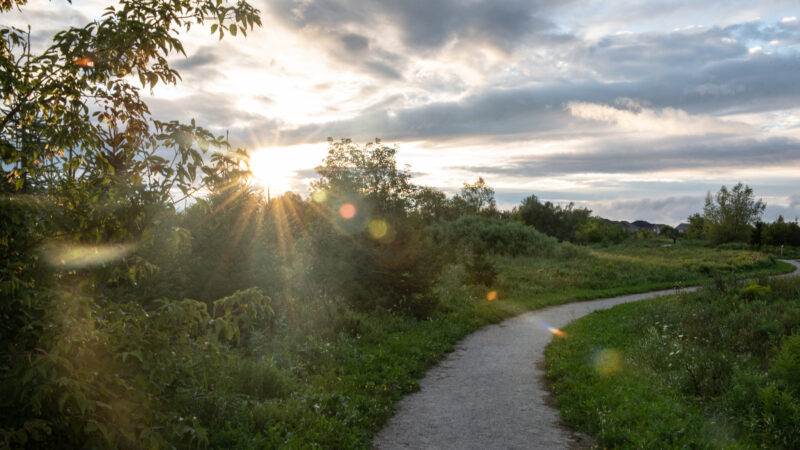Table of Contents Show
Do you consider visiting a national recreation trail when planning summer vacations, road trips, or weekend activities?
Some travelers love hopping from one national park to another. These locations capture some of the most beautiful places in our country.
But don’t forget about the lesser-known sites within the National Park System. For example, the national recreation trails offer all kinds of biking, hiking, horseback riding, and other fun outdoor activities for the whole family!
Let’s look at the newest trails so you can start planning your visit!
What Is a National Recreation Trail?
Within the United States, land and water-based trails provide recreational access to rural and urban communities and boost tourism that supports the local economy.
The intention of designating a trail as a “National Recreation Trail” is to elevate and promote state and local trails with regional significance.
To become a national recreation trail, the trail “must be open to public use, have no gaps, and be designed, constructed, and maintained according to best management practices.”
In addition, the trail must comply with land use plans and environmental laws and be available for public use for at least 10 years.
Who Manages Our National Recreation Trails?
The Secretary of Agriculture can designate national recreation trails on U.S. Forest Service lands. The Secretary of the Interior can designate trails on all other federal, state, and local lands.
The National Park Service, U.S. Forest Service, Bureau of Land Management, U.S. Corps of Engineers, and U.S. Fish and Wildlife Service all help maintain and protect these trails. State and local agencies also help manage national recreation trails.
For example, the U.S. Forest Service manages the Ouachita Trail in Arkansas because it runs through the Ouachita National Forest. However, the Clear Creek Trail in Colorado is a front-country, urban trail managed by a local agency (city or county).
Does It Cost to Visit a National Recreation Trail?
In general, national recreation trails have no fee to enjoy hiking, biking, paddling, or horseback riding. Many of these trails have offshoots and numerous points of entry.
Some of these trails run through state lines and in and out of national parks as well. So it would be difficult to establish a fee system.
The 9 Newest National Recreation Trails
In early June, an announcement revealed 340 miles across nine states now included in the National Recreation Trail System.
If you’re looking for something fun to do with the family or need a weekend excursion to get away from the daily grind of work, consider visiting one of these newly designated trails.
1. Crown Zellerbach Trail
Location: Oregon
Length: 22 miles
About: Crown Z Trail is open to hiking and horseback riding. The route travels through the wetlands of the Columbia River and follows the historic Portland and Southwestern Railroad.
For families who want a field trip outing, the interpretive signs teach about this area’s human and natural history. The trail is suitable for all ages and abilities.

2. Enterprise South Nature Park
Location: Tennessee
Length: 70 miles
About: Located in Chattanooga, the Enterprise South Nature Park is Tennessee’s longest national recreation trail. This system includes trails for mountain biking and horseback riding, and pedestrian-only trails.
The park has easy trails of less than one mile, intermediate, and more challenging trails to suit all types of bikers and hikers.
3. Fabulous Fox! Water Trail
Location: Wisconsin and Illinois
Length: 158 miles
About: A water trail is a marked route along navigable water systems such as rivers. Rafters, kayakers, canoers, and paddlers are all invited to visit the Fabulous Fox! Water Trail.
This national recreation trail runs through southeast Wisconsin and northeast Illinois on the Fox River system. It has dozens of access points, picnic shelters, restrooms, and campsites.
Although most of the water trail is gently flowing, seasonal rapids exist. Also, be aware of dams, high water, low bridges, and downed trees as you enjoy scenic beauty and water recreation.
4. Harris Greenway Trail
Location: Georgia
Length: 5.7 miles
About: Named after Lloyd N. Harris, the Harris Greenway Trail in Gwinnett County honors the man who helped create and protect public lands in this community.
The paved trail links Tribble Mill Park and Harbins Park, two local parks just outside Atlanta. This is a beautiful place to escape the city’s congestion and enjoy a stroll in a more natural setting.
Keep in Mind: Are you considering camping in a state park with your RV? Before you do, read the top 5 regrets of RV camping in a state park!
5. Iron Hills Trail System
Location: Utah
Length: 29 miles
About: Managed by the Bureau of Land Management, the Iron Hills Trail System in southwest Utah, near Cedar City, is known for its mountain biking opportunities. But hikers are also welcome.
Some bikers enjoy the Southview Skills Track’s rolling wooden ramps and wall ride. The BLM has plans to add 15 more miles to the trail system.
6. Old Highway 131 Trail
Location: Wisconsin
Length: 4.5 miles
About: The Old Highway 131 Trail lies within the Kickapoo Valley Reserve, which has been named a National Recreation Trail, a National Natural Landmark, an Important Bird Area, and one of Wisconsin’s Wetland Gems.
Visitors can hike, bike, camp, horseback ride, bird watch, hunt, fish, cross-country ski, snowmobile, and more. The Old Highway 131 Trail is paved for a leisurely bike ride, but horseback riders can also use the grassy shoulder.

7. Razorback Greenway
Location: Arkansas
Length: 40 miles
About: The Razorback Greenway connects the communities of Fayetteville, Johnson, Springdale, Lowell, Rogers, Bentonville, and Bella Vista in northwest Arkansas.
The paved trail is open to bikers, walkers, skaters, people with wheelchairs, and families with strollers. The trail connects three hospitals, 23 schools, and the corporate headquarters of Walmart, Tyson Foods, and J.B. Hunt.
It serves as a recreation trail and a transportation path for residents.
8. Vernon Bush Garden Trail
Location: Alabama
Length: 1 mile
About: The shortest trail on our list of new national recreation trails is the Vernon Bush Garden Trail in Jackson County Park. Like the Harris Greenway Trail in Georgia, this trail was named in honor of a longtime volunteer who worked to beautify the park.
Even though it’s only a mile long, it offers scenic lake views, picnic areas, and various plant and wildlife species.

9. Wilson Creek Trail
Location: Texas
Length: 10 miles
About: Linking Bonnie Wenk Park to Towne Lake Park, the Wilson Creek Trail sits just outside Dallas and offers a respite from the city’s congestion.
A unique feature of this national recreation trail is the 0.44-mile dog park loop. This scenic hike-and-bike trail is for walkers and bikers and is accessible by wheelchairs and strollers.
What’s the Difference Between a National Recreation Trail, a National Scenic Trail, and a National Historic Trail?
The National Trails System has three designations. National scenic and historic trails must demonstrate national significance. Usually, a National Park Service study determines eligibility and a federal land agency oversees the trail.
National scenic trails generally extend 100 miles or more, traversing beautiful terrain and connecting significant landmarks and public lands. For example, the Appalachian National Scenic Trail is over 2,190 miles long and runs from Georgia to Maine. It’s a bucket list item for many avid hikers.
National historic trails follow past routes of exploration, migration, struggle, trade, and military action. These trails allow visitors to retrace these historic events. For example, the Lewis and Clark National Historic Trail is nearly 4,900 miles long. It follows the routes of the Lewis and Clark Expedition of 1803 to 1806 from Pittsburgh, Pennsylvania, to the Pacific Ocean.
On the other hand, national recreation trails may have no federal oversight beyond the recognition. Agencies within the state, county, or city seek the designation and invest in and manage the trails.
This “recreation” designation complements the “scenic and historic” trails. They aren’t nearly as long and don’t necessarily have national importance but rather local significance.
Keep in Mind: Do you know how many National Parks are in the US? If not, the link to find out!

How Many Trails Are in the National Trails System?
The first national recreation trail was designated in 1969. Since then, almost 1,300 trails in all 50 states, including the District of Columbia and Puerto Rico, have joined the group. You can find a national recreation trail near you on the NRT website.
On the National Park Service’s website, you can find all the trails, including the national scenic and historic trails. There are currently 11 national scenic trails, including the 65-mile Natchez Trace Trail in Mississippi and the 3,100-mile Continental Divide Trail in the Mountain West and Southwest.
There are 20 national historic trails, including the 5,045 Trail of Tears stretching across nine states and the 54-mile Selma to Montgomery Trail in Alabama.
Enjoy Outdoor Adventure Along One of Our Nation’s Recreation Trails This Summer
Do you know if there’s a national recreation trail near you? With almost 1,300 across the country, you likely have easy access to a trail for hiking, biking, and horseback riding.
You can enjoy a national recreation trail with your kids or for a place to get some exercise or enjoy nature. Find one near you this summer, and begin a new habit of exploring your local trails!
Will you visit a national recreation trail this weekend?






